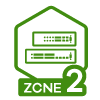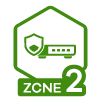Tutorial of Switch Link Aggregation (V4.80)
 Zyxel Employee
Zyxel Employee



Introduction
Link Aggregation is a feature that aggregates physical ports of a switch into a logical link, allowing it to accommodate more transmission traffic. Despite bundling multiple physical ports, the upper limit of transmission speed remains unchanged, as packets are still transmitted through a single route. A useful analogy is to envision link aggregation as lanes on a highway – the more lanes, the more vehicles (traffic) can be accommodated without congestion, but the speed is still constrained by the speed limit.
Zyxel switches support two methods of link aggregation: Static Binding (Trunking) and LACP (Dynamic Bonding).
Note: To prevent the formation of network loops, configuring link aggregation is a prerequisite before establishing physical connections on the devices.
Configuration Example
In this example, we aggregate ports 1 and 2 using Group ID T1 with static binding and aggregate ports 3 and 4 using Group ID T2 with LACP dynamic bonding.
Note: This tutorial provides example references; actual configurations should be applied based on your specific environment requirements, including the assignment of specific ports and whether to use "Static Binding" or "LACP Dynamic Bonding."
Configuration Steps
- Navigate to PORT > Link Aggregation > Link Aggregation Setting or use the quick link for Link Aggregation Setting.
- Configure ports 1 and 2 to be aggregated into Group T1 and ports 3 and 4 into Group T2. Click "Apply" to confirm.
- Active: Select the groups to enable.
- Criteria: Algorithm for packet distribution among ports in the group.
At the bottom of the same page, bind the ports into groups, and remember to click "Apply" after configuration. - Activate LACP functionality.
If the connected devices do not support or have not enabled LACP functionality, this step can be skipped.
(Note: LACP actively sends packets to confirm the liveliness of the connected ports. If there is no response from the other end, the port will be deactivated. Therefore, when using LACP, ensure that both ends have successfully enabled LACP.) - After configuration, click "Save" in the upper right corner to save the settings. Failure to do so may result in the loss of settings after a power outage.
- Check the link aggregation status through the Link Aggregation Status page.
Kay
Categories
- All Categories
- 441 Beta Program
- 2.9K Nebula
- 211 Nebula Ideas
- 127 Nebula Status and Incidents
- 6.4K Security
- 542 USG FLEX H Series
- 340 Security Ideas
- 1.7K Switch
- 84 Switch Ideas
- 1.3K Wireless
- 51 Wireless Ideas
- 6.9K Consumer Product
- 295 Service & License
- 464 News and Release
- 90 Security Advisories
- 31 Education Center
- 10 [Campaign] Zyxel Network Detective
- 4.7K FAQ
- 34 Documents
- 87 About Community
- 99 Security Highlight






